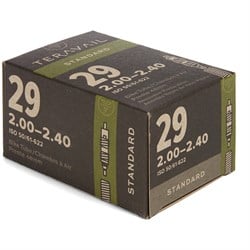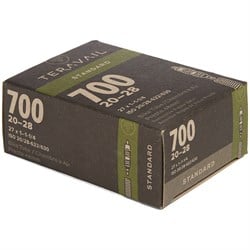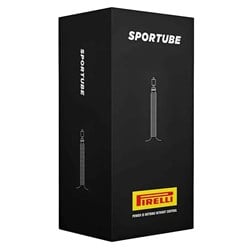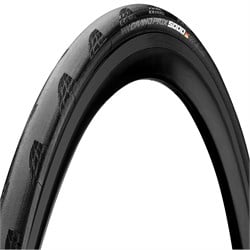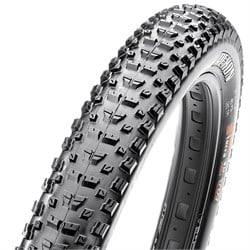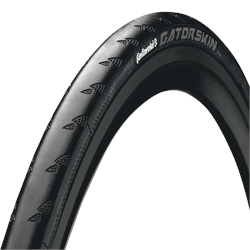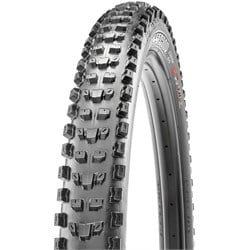How to Choose Bike Tires - Mountain, Road & More
Chocolate, Vanilla, or strawberry? Just like there’s no wrong answer to what kind of ice cream you like, there’s no wrong answer to what kind of tires you should snap onto your bike, just make sure that you’ve got the right rubber for the mood. Choosing the right bike tires is all about matching the tire to the type of bike and the type of riding. So, hop in and we’ll break down the different types of bike tires, from knobby downhill mountain bike tires to slick and smooth road bike tires, and how to pick the best tires for your bike and riding style.
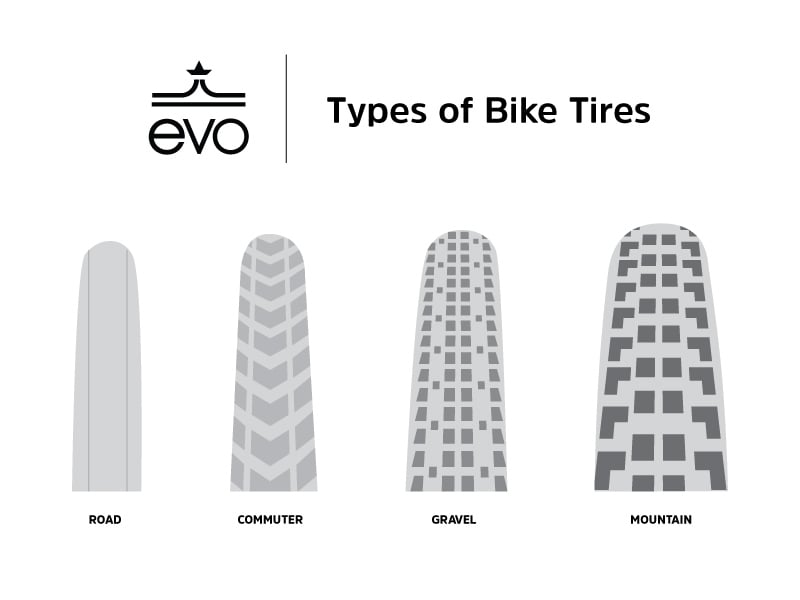
Types of Bike Tires
There are tons of different bike tires built for all sorts of different kinds of bikes, everything from skinny road racing slicks to big monster truck fat bike tires. In general, bike tires can be broken into a few different categories - organized by the type of riding.
Road Bike Tires
Kings of asphalt & spandex, road bike tires are going to be slick and fast like a used car salesman. The relative consistency of road conditions and bias for efficiency means these tires can be skinnier and smoother so that they roll faster. Road bike tires usually measure in the 18c (or mm) to 32c range and are run at high pressures between 80 and 120 psi for maximum performance. There’s no real need for texture either but your off-season tires might have a little bit of texture to keep you rubber side down thru a puddle or slick patch.
Urban / Commuter Bike Tires
The definition of commuter is pretty flexible so the tires are going to be as well. Some folks commuting long distances will basically ride road tires whereas someone who blasts thru campus might want some grip across a cranky neighbor’s lawn. Most “commuter-specific” tires remain relatively slick for efficiency, but sport wider widths for additional volume and comfort for rough/cracked streets as well as puncture protection features to keep you on schedule.
Gravel Bike & Cyclocross Tires
A relatively new category for the masochistic cyclocross racers as well as the adventure/bikepacker, many of these tires are slimmed-down versions of XC mountain bike treads. Think of gravel and cyclocross tires as a cross between road and mountain bike tires. These may also be a good option for commuters who want a little bit more grip. Gravel bike tires often feature lower-profile tread patterns in the center of the tire, for lower rolling resistance, and more aggressive knobs on the outside of the tire for better handling and traction through turns.
Mountain Bike Tires
Probably the most varied type of tire since the types of conditions are also varied. Hardpack dirt, loam, mud, clay and rock all require different knob patterns to keep you on your bike and to keep your Instagram page filled up for your fans. In general, mountain bike tires are much wider than other types of bike tires, with the high volume giving you the maximum grip and a cushier ride. Think of the air in your tires like an extra shock absorber. Plus, the tread pattern on mountain bike tires will be far more aggressive, to help you from sliding out in even the most sketchy of situations.
Generally, here’s what you can expect from modern bike tires in each category:
| Road Bike Tires | Urban/Commuter Tires | Gravel Bike Tires | Mountain Bike Tires | |
| Width | 18c - 38c | Various | 32c - 40c | 2.0" - 3"+ |
| Wheel Size | 700c | Various | 700c, 27.5" | 26", 27.5", 29" |
| Tread | Slick | Semi-slick | Small knobs | Very knobby |
How to Choose the Right Size Tire?
After you choose the type of bike tire that you’re looking for, you need to make sure that it will fit on your bike. Picking the right size tire comes with two main areas of measurement. Width and Diameter. Finding that goldilocks perfect tire can take some experimentation and testing as well as some soul searching to find out exactly what it is you’re trying to get out of your riding experience.
The diameter is pretty simple - it’s the size of your wheels. If you’re a mountain biker, you’re looking for 26”, 27.5” or 29”. Nearly all modern road bikes are 700c, which is actually the same as 29”. If you’ve rocking a vintage European steelie to go along with your vest and handlebar mustache and hipster attitude, it’s possible that it’s another esoteric old size. One surefire way to get the right size bike tire is to check out the spec on the side of the rim and/or the old tire to understand what diameter you’re working with. Diameter is not a preference, either it fits the wheel or it doesn’t.
Choosing the right width bike tire can be a little more tricky. Unfortunately, inconsistencies between the tire manufacturers can make this more difficult because apparently 2” doesn’t mean the same thing in Kenda as it does in Maxxis or Continental. A quick work around is to look at the stock brand/spec of tires for the bike or fork you’re looking to get the tire for and use it as a baseline. Keep in mind that you need space to allow for wheel and frame flex, fenders, mud clearance and possible woodland creature clearance. If you’re running a road bike with caliper brakes, you’ll make sure you’re clearing your stoppers as well.
Tire width also affects performance as it changes the size of the contact patch with the ground as well as the overall volume of the tire. The larger the tire is, the lower pressure you operate at and can keep the rim from banging on the ground, meaning more traction. This affects cornering, rolling resistance and overall traction as well as riding comfort. The tradeoff is generally in efficiency - fatter tires are going to be heavier and roll slower at a given pressure than thinner tires.
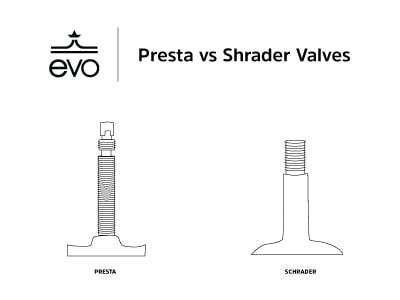
Choosing the Right Bike Tube Width and Valve Length
Bike tubes are pretty flexible and have a lot of room for error, but why not get it right to begin with? Similar to tire size, you’ll pick the diameter and width that’s appropriate for the tire you’re using. Don’t sweat this too much, inner tubes stretch so much it’s quite possible to inflate a 29” tire with a 26” tube in a pinch.
The valve can be a little tricky. Look at your rim and see if it’s drilled for a schrader or presta valve. You can stuff a presta valve into a schrader drilled hole, but not the other way around. It’ll be a bit loose fitting, but your wheel should come with an adapter that takes up the slack. If you’re using a presta valve, the length of the valve you’re using is somewhat important too. Most valve stems will be in the 40-50mm range and will clear the vast majority of rims. If you’re using super-techy-aero-deep-v rims, look up the rim depth on the manufacturer’s site and make sure the valve stem is an extra 5mm or so to clear it.
When to Replace Bike Tires?
Replace your tires when they start acting like a dead-eyed DMV rep; Not doing their job or at least not thrilled about it. This can be for any number of reasons including letting your dreams fade away. It's time to replace your bike tires when you see the following signs:
- Not holding air?
- Not providing the stopping power you like?
- Don’t trust the sidewalls any longer?
- Getting Squirrely in the corners?
When to Replace Mountain Bike Tires:
- Damage to or missing side knobs
- Overall wear of center knobs
- Sidewall Damage
- Bead Damage (especially for tubeless setups)
- Damage to casing
- General misshapenness or bulges
When to Replace Your Road Bike Tires
- Lack of tread
- Cuts or gashes
- Squaring-off of the tire profile (wear)
- Damage to casing
- Embedded wire, glass or other debris
What to Do with Old Bike Tires?
If you’re not wanting to have a black signal-fire running in your backyard, many bike shops and retailers have recycling programs where they can be disposed of in an environmentally friendly fashion. Once you’ve done your good deed for the year, you can reward yourself with an ice cream cone.
Wire vs Folding Bead Bike Tires
The bead of the rim is the part of the tire that mates up to the rim. There are two main styles of bike tire beads, wire and folding. Wire beads as are less expensive to manufacture. They tend to be much heavier and less flexible than folding beads as a result of the lower TPI. This makes them a bit harder to mount onto rims. Foldable beads are most often found on higher-end tires that are more flexible, have a higher TPI, and offer more traction.
What is Bike Tire TPI? Why Does it Matter?
TPI Stands for Threads Per Inch. Technically, Threads Per Square Inch but TPSI doesn’t quite roll off the tip of the tongue quite like TPI, does it? If you’re familiar with the thread count in your sheets, it’s similar and indicative of quality.
As you’re well aware by now, bike tires aren’t made of just rubber, but a number of materials go into a good tire. One of those things are nylon or aramid fibers or the “threads” that we’re counting here. Lower TPI casings use thicker threads that are less flexible but cheaper to manufacture. High TPI casings are flexible like a full-time hatha yoga instructor decked out in lululemon. This allows the casing of the tire to conform and flex to the road or trail you’re riding. Also, similar to a kevlar vest, it provides puncture resistance keeping all the air and fluids where they need to be to function.
The higher the TPI, the lighter the weight of the tire, and the more “supple” it will feel. Rule of thumb here is to simply buy as high a TPI as you can afford. This tends to be more of a factor for road tires as there’s less going on otherwise (in terms of tread pattern, etc…).
Tubeless / Tubeless Ready Bike Tires
Some tires are marked as “tubeless specific” or “tubeless ready”. This just means that the tire is made specifically or can work with tubeless setups. Physically, you can tell as the bead of the tire usually has a little extra sealing material.
The idea here is that it’s hard to puncture an inner tube when you don’t have one. Tubeless setups remove one of the weakest links in the wheel/tire system. You can pretty much say goodbye to pinch flats and pin-prick slow leaks as you replace the innertube with a tubeless-ready tire, rim sealing tape, and valve.
If you have a rim that’s designed to work with a tubeless setup, you can learn more with our guide on how to convert to tubeless bike tires. These tires will also work fine with tubes, but kinda like little jimmy sitting on the bench in little league, you’re not really seeing the tire to its full potential.
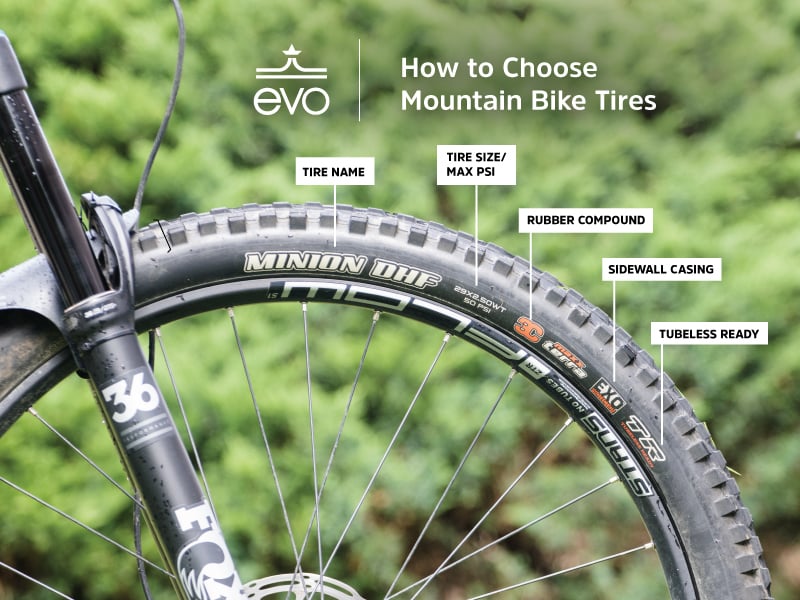
How to Choose Mountain Bike Tires
Just get Maxxis Minion DHF in as wide and thickly cased as you can in the front, Highroller 2’s in 2.3 in the back. Just kidding, but not really. You’ll find that experienced mountain bikers are very particular about the tires that they put on their bikes. The reason for this is that there’s so much personal preference and riding-style matching that goes on into tire choice. Here’s a few things to consider:
Mountain Bike Tire Casing & Sidewall Protection
If you’re riding in rocky, shale or chaussey conditions, extra sidewall protection can go a long way in protecting your tire and rims. Most brands have some kind of double-layer casing, or lighter-weight sidewall protection. Maxxis calls theirs “Maxx Shield” or “Double Down” and Continental calls theirs “Protection” or “Vectran.” Generally, the only penalty is weight so weigh this against how you typically ride. If you’re a park rat, go as heavy as you can. XC nerd? Keep it light and pick clean lines on your way down.
Mountain Bike Tire Rubber Compounds
Just like a good burger requires 100% All American Beef, a good tire requires good quality rubber from the get-go. Most of this comes from the flexibility and durability of the rubber. Generally speaking, lower-quality rubber will be harder and won’t conform to the road or trail and sacrifice grip for better-wearing properties, turning that wet corner into shoulder surgery. Softer compounds and mixes of these softer compounds go into some higher quality tires. Some will use soft, grippy rubber on the side knobs where they see less action, but in higher-consequence situations and keep the firm, longer wearing stuff in the middle. Other brands have some black-magic compounds formulated in an area-51 hangar that can somehow maintain both of these qualities but can hit the wallet a bit harder. This is a balance between rolling resistance, grip, and damage to the paycheck.
Bike Tire Tread Patterns
While it may seem complicated, it's actually fairly intuitive how tread patterns affect how a tire rides. This is mostly about when and where you trade rolling resistance for traction.
Side lugs provide support and traction when your turns are laid over aggressively. Big blocks of consistently spaced knobs here will provide a lot of cornering grip but won’t affect straight-line efficiency too much. Siping, or small slits, on the side knobs can increase traction but reduce longevity. Tires with fewer side lugs are effectively trading cornering ability for decreased weight and rolling resistance.
Center block patterns are pretty varied, but generally, there are variations in the size and spacing of those center blocks. Ramped knobs also trade some grip for increased rolling traction. These knobs affect how the bike rides when it’s going in a straight line or while braking. They’ll also wear the fastest since it’s where the tire spends the most time connected to the ground.
Additionally, the size of the center blocks allow the tire to bite through softer terrain like loamy or muddy trails. Smaller blocks are more efficient on hardpack terrain where you may only have a thin layer of sand or dust over hardpack to bite through.
As for in between shoulder knobs - there’s a good deal of variation here as well, but these knobs affect how the bike rides when cornering less aggressively where you’re steering or trimming into your turns. While having less blocks here can decrease rolling resistance, they can also create a “dead zone” where traction is questionable when transitioning to a hard lean.
Wide Tread Bike Tires
This is a design feature that some brands are offering now that there are some mega-wide rims floating around these days. It’s the same tread patterning and shapes but spaced out further to provide a rounder profile when running super wide rims. If you’re running a rim with an internal width wider than 30mm, it’s worth checking out wide-tread bike tires.
Learn More With Our Other Bike Guides:
- Mountain Bikes - How to Choose
- Mountain Bikes - Size and Fit Guide
- Mountain Bikes - How to Get Started Mountain Biking
- Mountain Bikes - How to Choose a Wheel Size
- Mountain Bikes - Suspension Basics
- Mountain Bikes - How to Choose a Mountian Bike Dropper Post
- Mountain Bikes - How to Choose MTB Handlebars
- Mountain Bikes - How to Choose MTB Pedals
- Mountain Bikes - How to Change Bike Pedals
- Mountain Bikes - How to Clean
- Mountain Bikes - How to Bleed SRAM Brakes
- Mountain Bikes - How to Bleed Shimano Brakes
- Mountain Bikes - How to Convert to Tubeless Tires
- Mountain Bikes - How to Replace Internal Cable Housing
- Mountain Bikes - How to Adjust Your Rear Derailleur
- Mountain Bikes - How to Bleed a RockShox Reverb Seatpost
- Mountain Bikes - How to Service Fox and RockShox Fork Lowers
- Mountain Biking - What to Bring Mountain Biking
- Mountain Biking - What to Wear Mountain Biking
- Mountain Biking - How to Choose Knee Pads
- Bikes - Size and Fit Guide
- Gravel Bikes - How To Get Started Gravel Biking
- eBikes - Classes, Features & More
- eBikes - Where to Ride eBikes
- Bike Accessories - Helmet Size & Fit Guide
- Bike Accessories - How to Choose Bike Shoes
- Bikes - How to Choose Bike Tires
- Bikes - How to Change Bike Pedals
- Bikes - How to Repair & Replace a Bike Chain
- Bikes - How to Choose Accessories
- Bikes - Urban Riding Tips
- Travel & Destination Guides - Where to Mountain Bike
Learn About our Favorite Bike Gear:
The Best Women's Mountain Bikes
The Best Electric Mountain Bikes
The Best Mountain Bikes for Beginners
The Best Mountain Bikes Under $3,000
The Best Trail Bikes
The Best Enduro Bikes
The Best Gravel Bikes
The Best Mountain Bike Helmets
The Best Full Face MTB Helmets
The Best Mountain Bike Knee Pads
The Best Mountain Bike Elbow Pads
The Best Mountain Bike Shorts
The Best Women's Bike Shorts
The Best Mountain Bike Pants
The Best Mountain Bike Jerseys
The Best Mountain Bike Accessories
The Best Value Mountain Bike Helmets
The Best Dropper Posts
The Best Mountain Bike Forks
The Best Mountain Bike Stems
The Best Padded Mountain Bike Shorts
The Best Mountain Bikes Handlebars
The Best Gifts for Mountain Bikers
The Best Mountain Bike Gloves
The Best Mountain Bike Socks
The Best MTB Fanny Packs
The Best Mountain Bike Backpacks
The Best Clipless Mountain Bike Shoes
The Best Flat Pedal MTB Bike Shoes
The Best Mountain Bike Tires
The Best Mountain Bike Flat Pedals
The Best Bike Racks
The Best Bike Glasses
The Best Bike Goggles
The Best Women's Mountain Bike Jerseys
The Best Tailgate Bike Pads
The Best Bike Trainers
The Best Hitch Bike Racks
The Best Clipless MTB Pedals
The Best Mountain Bikes Handlebar Bags
The Best Mountain Bike Saddles
The Best MTB Wheels
The Best MTB Grips
The Best Mountain Bike Multi Tools
The Best Mountain Bike Seat Bags
Popular Bike Searches
